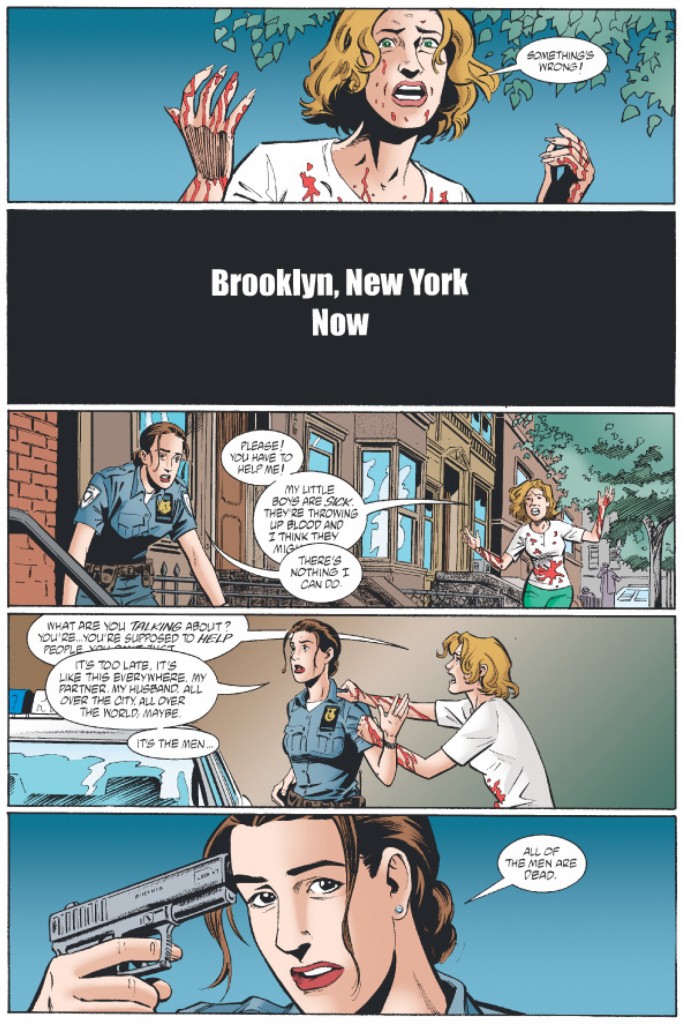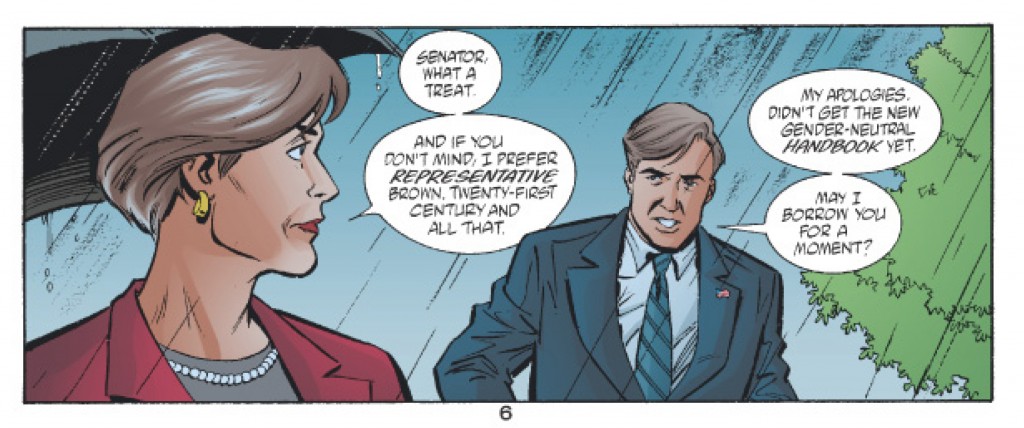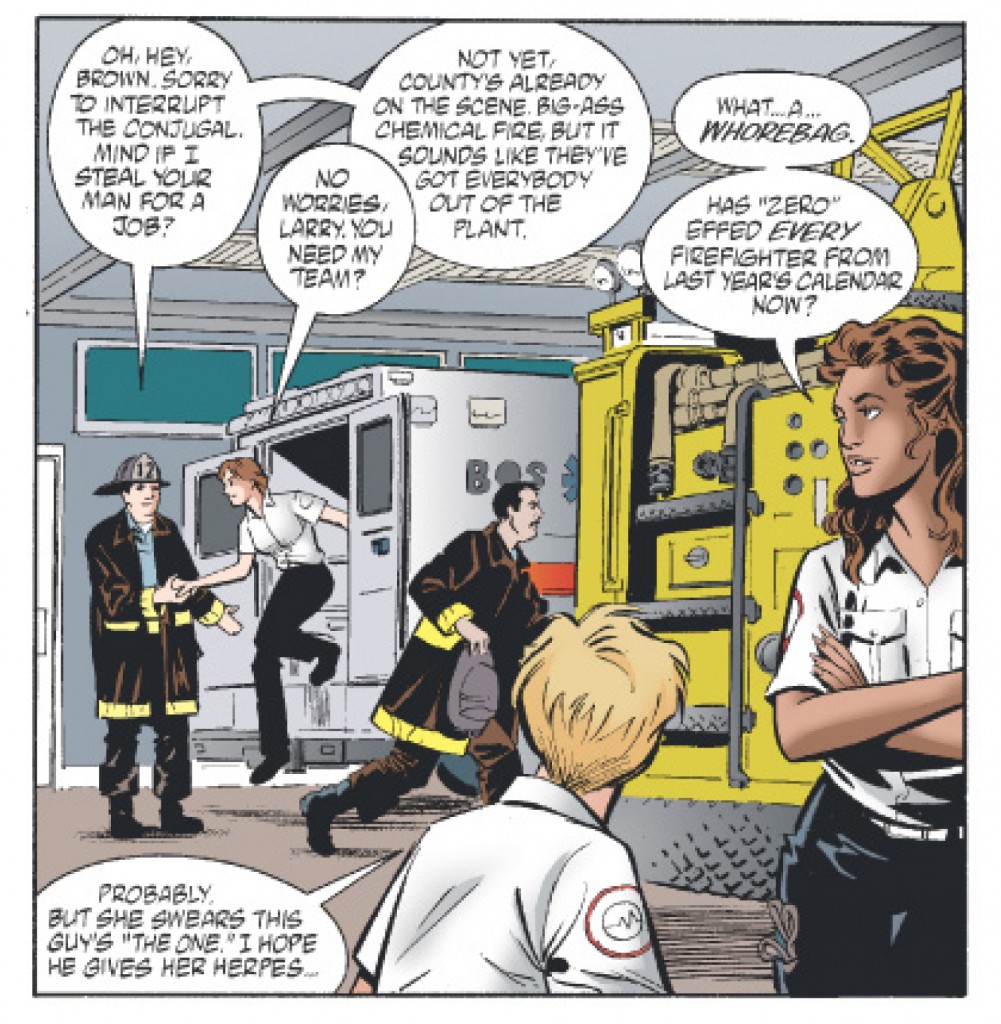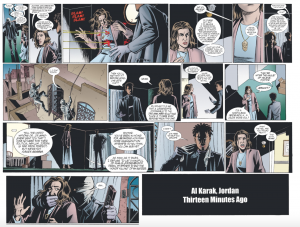
I’m a nerd. It’s true. Always have been. Sometimes I’ve just thrown people off with nice clothes and the occasional hippy hairstyle. Thankfully, nerds have now taken over cool. And thus, it should come as no surprise that one of my favourite types of media to bring into class every once in a while is graphic novels.
They don’t get the use they could in our classrooms or even talked about too often. I’ve heard of their existence in ELT markets (here), but never known anyone to use these. Really, DC comics and Marvel dominate with hundreds of high-interest titles. Why not use them? Is it because they’re still not mainstream? Movies like Iron Man should help there. Is it because teachers think they’re meant for kids? Check out The Walking Dead; you’ll change your mind. Maybe it’s just because no one’s shown what they do. I can help here. So what are the benefits? The first that come to mind are:
Graphic novels add a visual to a text.
Graphic novels texts are often conversationally driven.
Graphic novels have manageable amounts of text.
Graphic novels allow time to digest a visual story.
Graphic novels are easy to photocopy and modify.
Originally, I’d planned to include three of my favourite comics here, but the more I worked with the post, the less X-Men Zombies and Wonder Woman seemed a natural fit here. So, I bring you ideas for the ELT classroom from one of my favourite comics, Y The Last Man (Issue #1 is freely available here), which lacks superheroes, good guys and bad guys and happy endings (in fact, it’s full of mature language and themes), but it begs for a movie adaptation. I can’t tell you more or it’ll ruin your experience of the activities below–my suggestions for what you could do with almost any comic.
Predict the story
Just like a traditional text, learners can make predictions about the story but this time based on images. Here is the first page of this story.

Why do you think all the men are dead? Why is the woman pointing the gun at her head? If this is the first page, what do you think the story will be about?
Frames that include discourse markers
Choosing frames that include discourse markers can challenge learners to think critically about what they can determine happened just before, what’s happening now and what may happen next. Here are four frames I’ve cut out from different sections of issue #1 (click on any for a larger version) and some sample questions that could be asked of learners to consider.

Scene A (above) – Why does Yorick (main character) say “Sorry, that was mommy dearest”? What does his mother do? Where is Beth (female in the next frame)? Why does Beth say “no offence, of course” to Yorick? What is “ampersand”?

Who is the woman? How does she feel about meeting this man? What did the man likely do just before this frame?

Scene C – Why is the woman in the hospital? What is going to happen shortly?

Scene D – What was the woman coming out of the ambulance doing before this? Why did the fireman interrupt her? What is her name? How do the other woman feel about her? Why? How does she feel about “this guy”?
Descramble a scene
Mixing up the frames requires learners to use the available text and imagery to interpret how one frame relates to another. Here is another scene that has been mixed up (very easy to do by cutting up the square frames, by the way). Can you determine the order?
Novel in an hour
Graphic novels or better yet, individual issues of comics like this one, are perfect for the novel in an hour activity. Give each group of students a few pages, rearrange the pages so that the same characters are together (this issue, for instance, bounces around several different scenes that you could easily cut up and collate together per group).
Fill in the gaps
One of the more obvious ways to utilise scenes from graphic novels is to blank out some of the callouts for learners to practice language they’re working on. I’ve taken an interesting scene, left the opening and kept a twist just to get learners thinking creatively. Click for PDF.
In the end, these are just sample activities with a sample graphic novel to encourage any use of them. And just in case your interest has been piqued, check out the series Y The Last Man. Enjoy!
Check out Janet Bianchini’s curated resources about using graphic novels.
If you’ve ever used graphic novels with your classes, which ones did you find worked well? Even better, could you blog what you did with them? =)


Great stuff, Tyson. Some of the themes in graphic novels are really dense. And I mean that in a good way. Great example you’ve chosen, but you could also do some topics like loneliness and isolation with novels like Watchmen or Raymond Brigg’s The Man, where a young boy comes across a little man who is about 4 inches tall! X-Men is obviously a lot about acceptance and prejudice. They don’t have to always be so long though – newspaper comic strips often cover as meaty topics. Think Calvin and Hobbes or Andy Capp.
Did you know that Heinle have produced graphic novel versions of classic literature. I have a copy of Great Expectations that I picked up at the British Council. Haven’t used it in class yet, as I need to work out how I’d tackle it with pre-int, but what a cool resource.
I actually studied bande dessinée at university, which was really interesting. If a teacher is using these to teach French, I’d recommend L’autoroute du soleil, Le cahier bleu and anything by Dupuy et Berbarian. What I’d add to your suggestions above, and probably at higher levels only, would be discussing the form of the graphic novel in the same way as film. Discussing the mise en scene, other meta terminology of the medium and things like representation of diegetic and non-diegetic sound effects.
Great stuff, thanks for sharing!
Andy Capp? Seriously? 😉 I have used some comic strips as well as political cartoons too – all great stuff. I have so many comics though, that I always feel I need to make use of them beyond my first read (and then in a bag and board for life).
I did actually link to the Heinle books in the post near the beginning. I’ve never used them nor actually seen them in person. Good ideas, but as I said, mainstream comics might have a little more appeal.
There’s a bunch from your last paragraph I actually don’t understand myself, but I get the gist and would love to give some attention to genre analysis and the meta-concepts around this medium.
=) Do you have favourite comics yourself?
Mise en scene basically is what you can see in the shot/frame (therefore also what you can’t see), how it privileges certain characters or objects. For example, Superman might appear above his foe in the frame and so appear more important or valiant. Diegetic and non diegetic elements are about breaking the fourth wall – so sound effects (rrrrrring, bamf!, wham, etc). L’autoroute du soleil is brilliant, like a buddy-road movie, great stuff. Le cahier bleu is all about how events are interpreted by different characters in the novel.
My fave? Probably Spider-man. #fanboy =)
Awesome. Thanks for the definitions, which all make perfect sense and are elements I’m keenly aware of but never describe properly (evidently)!
As for Spidey, I took up Ultimate Spider-man when it came out to avoid all the continuity baggage – loved it. It was written by Bendis, who went on to revamp the main Avengers titles and so many more.
You couldn’t hide the nerd from me, Ty… takes one to know one anyhoo 😉
I’ve taken single slide comics or as we might call them in the US, “funnies” into class. Not always humorous ones, though, because that ain’t always so easy. Spent an entire hour in discussion on this dandy:
http://spendmoneyonline.net/wp-content/uploads/2008/11/the_fence.jpg
That’s a good one. I have used like comic strips, mostly shorter ones like Calvin and Hobbes or political cartoons.
Thanks for the find, fellow nerd, but when I saw the URL, I did have my doubts about clicking on it… 😉
yeah… i couldn’t find the original source… funny how the original sharer is probably on page 20 in google and yet that bogus site is first page… alas…
Merci 4 clicking all the same, fellow nerd 😉
We used Jane Eyre from the Heinle series in our lower intermediate class with good success this last semester. It was our first go at it. The teacher who used it liked it. I had planned on using it, but I didn’t get to teach the class because of a scheduling conflict. We got Heinle to package the graphic novel with the audio CD. The teacher reported that the audio CD helped the students a lot. I like some of the suggestions for how to use the novel in class.
Cool, John – thanks for the comment. Glad you liked some of the suggestions. Hope you get to use graphic novels at some point with your classes.
Ideas for using graphic novels http://t.co/uZC4356M via @seburnt #eltchat #edchat
I used to live with 2 comic fans who spent hours drooling over their collections.
I had a colleague who was a world expert on cartoons and he used them and comics in practically all his classes even exam prep.Not sure what he did exactly but his students liked it.Seemed to be his approach rather than the material.
Great post.
I probably have 2000+ individual issues in bags and boards in my closet. It became an obsession for a few years until finally I had to accept that I didn’t have the space to store any more. Finally, I narrowed it down to just two titles per month…
Great post! I’m a huge comics fan and have tried to integrate them in class a few times. With all the films and TV series based on comic characters being made now, it is a useful way to get students to compare the differences between print, comics and film. I have had had some success with Alan Moore’s V For Vendetta, which ties in nicely with discussions about the 5th of November.
You are so right. I recently came across the webpage below that compares the Walking Dead comic characters to those of the TV series. Uncanny how closely they follow it sometimes, right down to the clothes and expressions. Might be a good one for Brad Patterson’s Compare/Contrast post challenge: http://blog.edulang.com/blog-challenge-compare-and-contrast-photo/
Comparison of the characters
http://www.zombiephiles.com/zombies-ate-my-brains/walking-dead-comic-show-character-comparison
Compares the storyline of episodes episode by episode
http://www.comicvine.com/news/amcs-the-walking-dead-comics-comparison-and-analysis/142588/
Thanks @leoselivan for pointing me towards these great ideas for using graphic novels http://t.co/UyNc0tZw by @seburnt.
Some great Ideas for using graphic novels – useful resources, thank you!
Tyson
Thank you for the great ideas and links.
I create comics using online applications but really want to have graphic novel caricatures for adults, which are hard to find.
With comic life & pixton pics I can import images but wonder about copyright issues from some of those sample comic books you’ve used in your examples.
Pixton is the closest I’ve got to being able to manipulate images and create adult-like characters.
I have used comics for visual effects,grammar & mostly, for collaborative story telling.
I wonder if there is an online collection of comics like the project gutenburg one for books?
Inspired by this article I’ve done a search and found this
http://www.lorencollins.net/freecomic/
http://free-online-novels.com/graphic.html
I think I would want to mix and match images to create new comics or blank out text to create new versions or blank ones etc.
http://www.shambles.net/pages/learning/EnglishP/comics/
Appreciate the research you’ve done. I haven’t tried any of those tools. Personally, I don’t think copyright is too worrisome if you are using copies without the speech bubbles. It’s not like you’re copying the whole book and selling it. Educational purposes usually allow for a certain copyright leeway.
[…] fourc.ca – Today, 4:10 PM […]